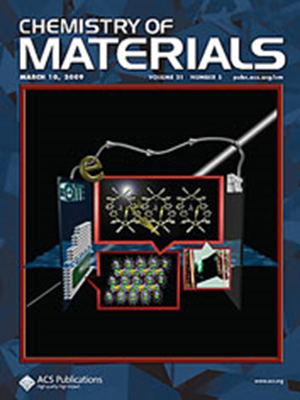MXene类似物:用于电催化的亚稳态二维过渡金属氮化物
IF 7.2
2区 材料科学
Q2 CHEMISTRY, PHYSICAL
引用次数: 0
摘要
亚稳态二维(2D)材料由于其非平衡表面状态和可调谐的电子结构,为克服电催化中热力学稳定相的固有局限性提供了一种很有前途的策略。其中,亚稳相二维过渡金属氮化物(Meta-2D TMNs)是MXenes的结构类似物,由于其类似贵金属的电子构型和优异的导电性,具有显著的电化学能量转换潜力。然而,Meta-2D TMNs的可扩展合成和性能优化仍然具有挑战性。这些挑战主要源于高能二维结构在形成过程中的不稳定性和竞争性副反应,例如氨前体的分解,在高温下促进氮三键的形成。本文系统地评价了开发高性能Meta-2D tmn基电催化剂的新合成策略和设计原则。关键主题包括地层机制,热力学和动力学障碍,以及在抑制不良副反应的同时降低地层能量的方法。特别强调的是结构和组成工程在调整电催化性能中的作用,从而促进了对亚稳系统中结构-性质关系的理解。本文综述了Meta-2D TMNs在控制合成、基本结构-性质关联和亚稳化合物探索等方面的研究进展,对Meta-2D TMNs的合理设计及其在可持续能量转换和存储技术中的潜在应用进行了展望。本文章由计算机程序翻译,如有差异,请以英文原文为准。

MXene Analogue: Metastable Two-Dimensional Transition Metal Nitrides for Electrocatalysis
Metastable two-dimensional (2D) materials offer a promising strategy to overcome the intrinsic limitations of thermodynamically stable phases in electrocatalysis, owing to their nonequilibrium surface states and tunable electronic structures. Among them, metastable-phase 2D transition metal nitrides (Meta-2D TMNs), structural analogues of MXenes, exhibit significant potential for electrochemical energy conversion due to their noble-metal-like electronic configurations and excellent electrical conductivity. However, the scalable synthesis and performance optimization of Meta-2D TMNs remain challenging. These challenges primarily stem from the instability of high-energy 2D structures during formation and competing side reactions, such as the decomposition of ammonia precursors that promote nitrogen triple-bond formation at elevated temperatures. This review systematically evaluates the emerging synthetic strategies and design principles for developing high-performance Meta-2D TMN-based electrocatalysts. Key topics include formation mechanisms, thermodynamic and kinetic barriers, and approaches to lower formation energy while suppressing undesirable side reactions. Particular emphasis is placed on the role of structural and compositional engineering in tuning electrocatalytic performance, thereby advancing the understanding of structure–property relationships in metastable systems. By highlighting advances in controlled synthesis, fundamental structure–property correlation, and the exploration of metastable compounds, this review provides insights into the rational design of Meta-2D TMNs and their potential applications in sustainable energy conversion and storage technologies.
求助全文
通过发布文献求助,成功后即可免费获取论文全文。
去求助
来源期刊

Chemistry of Materials
工程技术-材料科学:综合
CiteScore
14.10
自引率
5.80%
发文量
929
审稿时长
1.5 months
期刊介绍:
The journal Chemistry of Materials focuses on publishing original research at the intersection of materials science and chemistry. The studies published in the journal involve chemistry as a prominent component and explore topics such as the design, synthesis, characterization, processing, understanding, and application of functional or potentially functional materials. The journal covers various areas of interest, including inorganic and organic solid-state chemistry, nanomaterials, biomaterials, thin films and polymers, and composite/hybrid materials. The journal particularly seeks papers that highlight the creation or development of innovative materials with novel optical, electrical, magnetic, catalytic, or mechanical properties. It is essential that manuscripts on these topics have a primary focus on the chemistry of materials and represent a significant advancement compared to prior research. Before external reviews are sought, submitted manuscripts undergo a review process by a minimum of two editors to ensure their appropriateness for the journal and the presence of sufficient evidence of a significant advance that will be of broad interest to the materials chemistry community.
 求助内容:
求助内容: 应助结果提醒方式:
应助结果提醒方式:


